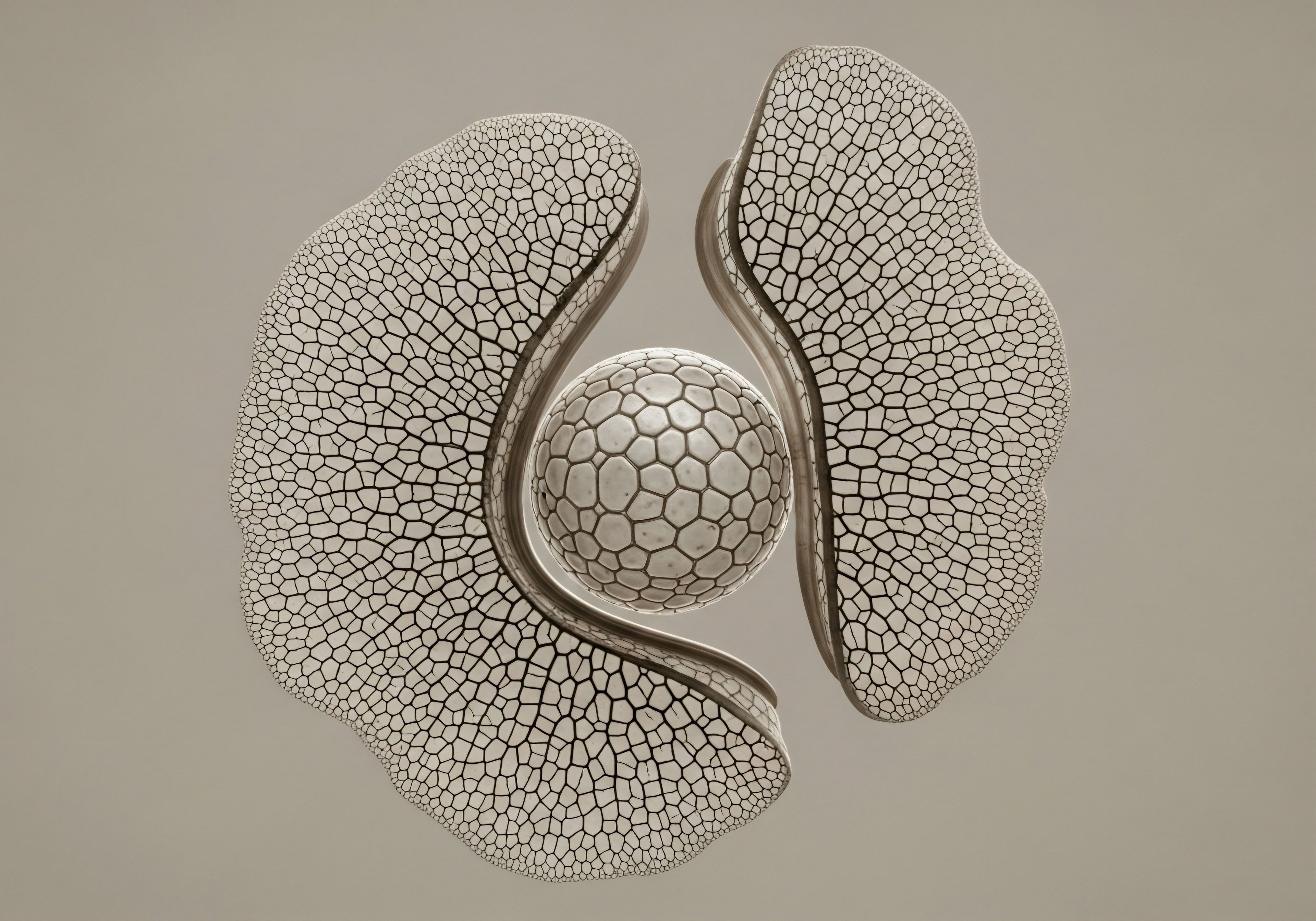

Fundamentals
The feeling is unmistakable. A profound fatigue that settles deep into your bones, a mental fog that clouds your thoughts, and a frustrating sense of being metabolically stuck, no matter how carefully you eat or how consistently you move. You may have even had your thyroid checked, only to be told the numbers fall within the standard range.
This experience, this disconnect between how you feel and what a basic lab report shows, is a valid and deeply personal starting point for understanding your body’s intricate internal communication network. Your lived symptoms are the most important data set you possess. They are the signal that invites a deeper inquiry into the elegant, yet sensitive, processes that govern your vitality.
At the center of this system is your thyroid gland, the master regulator of your body’s metabolic rate. It functions like the conductor of an orchestra, setting the tempo for how quickly every cell in your body generates and uses energy.
The process begins when the pituitary gland in your brain sends out a signal, Thyroid-Stimulating Hormone (TSH), telling the thyroid to get to work. The thyroid’s primary product is a molecule called thyroxine, or T4. It is important to recognize T4 as a storage, or pro-hormone.
It circulates in your bloodstream in relatively large quantities, acting as a reservoir of potential energy. The true metabolic power, the energy that warms you, clears your mind, and fuels your muscles, comes from the conversion of this T4 into the much more potent, active hormone, triiodothyronine, or T3.
The journey from feeling tired and unwell to reclaiming vitality begins with understanding that your body’s energy is unlocked through a specific biochemical conversion process.
This conversion is the entire point of the system. It is the critical step where potential energy becomes kinetic action at the cellular level. This transformation is not automatic; it is an active, enzymatic process. Your body uses a specialized set of enzymes called deiodinases to carefully clip one iodine atom from the T4 molecule, turning it into the biologically active T3.
These enzymes are the tireless workers on the cellular assembly line, responsible for manufacturing the very hormone that dictates your metabolic function. When this conversion process is efficient, you feel vibrant, clear-headed, and resilient. When it falters, you experience the classic symptoms of a slow metabolism, even if your thyroid is producing plenty of T4.
The integrity of this conversion machinery depends directly on the availability of specific raw materials. Micronutrients, the vitamins and minerals we obtain from our diet, function as essential components of these deiodinase enzymes. They are the specialized tools and dedicated power sources required for the conversion to occur.
Without them, the entire process can slow down or become dysfunctional. Two of the most significant of these micronutrients are selenium and iron. A deficiency in these key elements can directly impair the function of the deiodinase enzymes, creating a bottleneck in your metabolic pathway.
Your body may have an abundance of the T4 storage hormone, but it lacks the necessary biochemical tools to transform it into the active T3 that your cells desperately need to function correctly. This is the starting point for understanding how subtle nutritional shortfalls can have such a significant impact on your overall health and well-being.


Intermediate
To truly grasp how micronutrient status governs your metabolic tempo, we must look closer at the specific enzymatic machinery involved. The conversion of T4 to T3 is managed by a family of deiodinase enzymes, each with a distinct role and location within the body.
Think of them as specialized technicians operating in different departments of a large corporation. Type 1 deiodinase (D1) is found primarily in high-activity tissues like the liver and kidneys. It is responsible for producing a significant portion of the circulating T3 in your bloodstream.
Type 2 deiodinase (D2) operates more locally within specific tissues, including the brain, pituitary gland, and skeletal muscle. It acts as a highly sensitive local regulator, ensuring these critical tissues get the precise amount of active T3 they need, directly from the available T4. Finally, Type 3 deiodinase (D3) performs the opposite function.
It is the system’s primary brake, converting T4 into an inactive form called reverse T3 (rT3). This inactivation pathway is a protective mechanism, designed to slow metabolism during times of extreme stress or illness. The balance between the activity of D1 and D2 versus D3 determines the amount of active T3 your body has available to use.

The Central Role of Selenium
Selenium is a trace mineral with a profound influence on thyroid physiology. The thyroid gland itself has the highest concentration of selenium per gram of tissue of any organ in the body, a clear indication of its importance. This is because the deiodinase enzymes are actually selenoproteins, meaning a selenium atom is built directly into their core structure.
Specifically, it is present as a rare amino acid called selenocysteine, which forms the catalytic heart of the enzyme. Without sufficient selenium, the body cannot properly construct these vital enzymes. A selenium deficiency directly impairs the function of D1 and D2, leading to a measurable decrease in the conversion of T4 to T3.
This creates a scenario where TSH and T4 levels might appear normal on a lab test, but the low level of active T3 results in the pervasive symptoms of hypothyroidism. Furthermore, selenium is a key component of another family of selenoproteins, the glutathione peroxidases, which protect the thyroid gland from the oxidative stress generated during hormone production.

Iron the Foundational Element for Synthesis and Conversion
Iron’s role in thyroid health is twofold. Its most well-known function is as a component of hemoglobin, the protein that carries oxygen in the blood. Its importance in endocrinology is just as foundational. The primary enzyme responsible for synthesizing thyroid hormones in the first place, thyroid peroxidase (TPO), is a heme-dependent enzyme, meaning it requires iron to function.
An iron deficiency can therefore limit the thyroid’s ability to produce T4 at the very start of the process. Beyond synthesis, iron is also necessary for the efficient conversion of T4 to T3. Studies have shown that iron deficiency, often identified by low levels of its storage form, ferritin, is associated with reduced T4-to-T3 conversion and elevated levels of the inactive reverse T3.
This suggests that low iron status can both slow the “on-ramp” of thyroid hormone production and simultaneously put the brakes on its activation in peripheral tissues.
The intricate balance of thyroid function relies on a symphony of micronutrients, where a shortfall in one can disrupt the entire metabolic performance.

How Do Sex Hormones Influence This System?
The endocrine system is a web of interconnected signals, and your sex hormones have a direct impact on thyroid function. Estrogen, for instance, can increase the liver’s production of thyroxine-binding globulin (TBG), the primary protein that transports thyroid hormones in the blood.
When more TBG is present, more thyroid hormone becomes bound and inactive, reducing the amount of free, usable T3 and T4. This is particularly relevant for women on estrogen therapy or those experiencing conditions of estrogen dominance. Testosterone also plays a part.
It can influence the expression of thyroid hormone receptors in various tissues, modulating how effectively the T3 message is received. Therefore, optimizing sex hormone levels, as is the goal with protocols like TRT for men and hormonal balancing for women, is an important consideration in achieving optimal thyroid function. The body’s systems do not operate in isolation; they are in constant communication.
The following table outlines the distinct roles of key micronutrients in the lifecycle of thyroid hormones.
| Micronutrient | Role in Hormone Synthesis | Role in T4-to-T3 Conversion | Impact on Hormone Action |
|---|---|---|---|
| Selenium | Protects thyroid gland from oxidative stress during synthesis via glutathione peroxidase. | Directly incorporated into deiodinase enzymes (D1 and D2) required for T3 activation. | Enables production of the active hormone that binds to receptors. |
| Iron | Essential component of the heme-dependent thyroid peroxidase (TPO) enzyme. | Supports efficient conversion and helps prevent shunting of T4 to inactive reverse T3. | Ensures adequate oxygen supply to tissues for metabolic activity. |
| Zinc | Participates in the synthesis of TSH in the pituitary gland. | Acts as a cofactor for deiodinase enzymes, supporting T3 production. | A structural component of thyroid hormone receptors, required for T3 to bind and exert its effect. |

The Impact of Stress and Inflammation
Chronic physiological or psychological stress is a powerful disruptor of thyroid conversion. During periods of high stress, the adrenal glands produce elevated levels of cortisol. Sustained high cortisol directly inhibits the activity of the D1 and D2 enzymes while simultaneously upregulating the D3 enzyme.
This biochemical shift actively shunts T4 away from the activating T3 pathway and down the inactivating reverse T3 pathway. From a biological perspective, this is a short-term survival strategy to conserve energy during a crisis.
In the context of modern chronic stress, this mechanism becomes maladaptive, leading to a state of cellular hypothyroidism characterized by high rT3, low T3, and persistent symptoms of fatigue and metabolic slowdown. Systemic inflammation, driven by factors like poor diet, gut dysbiosis, or chronic illness, generates inflammatory messengers called cytokines that produce the same inhibitory effect on T4-to-T3 conversion.


Academic
A sophisticated analysis of thyroid physiology moves beyond a simple linear model and adopts a systems-biology perspective. The regulation of metabolic homeostasis is governed by the dynamic interplay between the Hypothalamic-Pituitary-Thyroid (HPT) axis, the Hypothalamic-Pituitary-Adrenal (HPA) axis, and the Hypothalamic-Pituitary-Gonadal (HPG) axis.
These systems are in constant, bidirectional communication, and a perturbation in one inevitably affects the others. Specific micronutrient deficiencies act as potent systemic stressors that can destabilize this delicate regulatory network, primarily by impeding the peripheral conversion of thyroxine (T4) to triiodothyronine (T3).
This impairment is a central feature of what is clinically observed in Non-Thyroidal Illness Syndrome (NTIS), also known as Euthyroid Sick Syndrome, where patients with severe illness exhibit low T3 levels despite a structurally normal thyroid gland. Understanding the molecular underpinnings of this phenomenon provides a clear window into how nutrient status dictates endocrine function.

Molecular Mechanisms of Deiodinase Impairment
The deiodinase enzymes are the focal point of this regulatory control. The Type 1 and Type 2 deiodinases (D1, D2) are selenoenzymes, containing a selenocysteine residue at their active site that is absolutely required for their catalytic activity. This residue facilitates the reductive deiodination of the outer ring of the T4 molecule.
A state of selenium deficiency results in decreased synthesis and expression of functional deiodinase enzymes, creating a hard ceiling on the rate of T3 production. Research has demonstrated that in combined selenium and iodine deficiency, the resulting hypothyroidism is more severe than in iodine deficiency alone, highlighting selenium’s critical role in maximizing the utility of available iodine.
Iron’s role is equally critical, though mechanistically distinct. Its function within the heme-containing thyroid peroxidase (TPO) enzyme is foundational for hormone synthesis. Iron deficiency anemia has been shown to reduce TPO activity, thereby decreasing T4 output. Peripherally, low iron status, reflected by low serum ferritin, correlates strongly with higher levels of reverse T3 (rT3).
This indicates that iron availability influences the allosteric regulation or expression of the deiodinase enzymes, favoring the inactivating D3 pathway when iron is scarce. Zinc contributes at multiple levels; it is required for the synthesis of Thyrotropin-Releasing Hormone (TRH) in the hypothalamus, influences TSH output from the pituitary, and is a structural component of the zinc-finger motifs within the nuclear thyroid hormone receptors themselves.
A lack of zinc can therefore impair the signal to make thyroid hormone and also prevent the active T3 from successfully binding to its receptor and initiating gene transcription.

What Is the Clinical Signature of a Conversion Disorder?
The biochemical pattern of impaired T4-to-T3 conversion presents a distinct signature on advanced laboratory testing, which differs from primary hypothyroidism. In primary hypothyroidism, the thyroid gland itself is failing, leading to low T4 and a compensatory high TSH.
In a conversion disorder driven by nutrient deficiency or inflammation, the TSH and T4 levels may be within the normal laboratory range. The key markers are a low free T3, a high reverse T3, and consequently a low free T3/reverse T3 ratio. This ratio is arguably one of the most sensitive indicators of peripheral thyroid function and cellular metabolic stress.
Assessing the ratio of active T3 to inactive reverse T3 provides a direct view into the body’s real-time metabolic status at the cellular level.
The table below contrasts the typical laboratory findings in primary hypothyroidism versus a state of poor peripheral conversion.
| Lab Marker | Primary Hypothyroidism | Poor T4-to-T3 Conversion |
|---|---|---|
| TSH (Thyroid-Stimulating Hormone) | High | Often Normal, can be low-normal |
| Free T4 (Thyroxine) | Low or Low-Normal | Normal or even slightly high |
| Free T3 (Triiodothyronine) | Low | Low |
| Reverse T3 (rT3) | Normal or Low | High |
| Free T3 / Reverse T3 Ratio | Variable, may be normal | Low |

Integration with Hormonal Optimization Protocols
This understanding of nutrient-dependent conversion is essential when implementing advanced clinical protocols like Testosterone Replacement Therapy (TRT) or Growth Hormone Peptide Therapy. A patient seeking to optimize their hormonal milieu to improve energy, body composition, and vitality will have their results blunted if a foundational metabolic pathway is compromised.
For instance, administering Testosterone Cypionate to a male with low ferritin and selenium levels may improve androgen-specific symptoms, but the expected global increase in metabolic rate will be constrained by the bottleneck in T3 production. The body cannot fully leverage the anabolic signals from testosterone without sufficient cellular energy, which is governed by T3.
Similarly, peptide therapies like Sermorelin or CJC-1295/Ipamorelin, which aim to increase endogenous growth hormone production, rely on a well-functioning metabolic engine to achieve their full effect on tissue repair and fat metabolism. Therefore, a comprehensive clinical approach involves assessing and correcting micronutrient deficiencies as a foundational step.
This ensures the entire endocrine system is supported, allowing for targeted hormonal interventions to be maximally effective and safe. The goal is to restore the body’s interconnected systems to a state of high function, and that process begins at the most fundamental level of cellular biochemistry.

References
- Arthur, J. R. Nicol, F. & Beckett, G. J. (1992). The role of selenium in thyroid hormone metabolism and effects of selenium deficiency on thyroid hormone and iodine metabolism. Biological trace element research, 34(3), 321 ∞ 325.
- Baltaci, A. K. Mogulkoc, R. & Belviranli, M. (2019). The Role of Zinc in Thyroid Hormones Metabolism. International Journal for Vitamin and Nutrition Research, 89(1-2), 85-93.
- Beserra, J. B. Morais, J. B. S. & Severo, J. S. (2021). Relation Between Zinc and Thyroid Hormones in Humans ∞ a Systematic Review. Biological Trace Element Research, 199(12), 4468-4476.
- Chatterjee, S. Chakrabarti, P. & Sinhamahapatra, P. (2021). Relationship between iron metabolism and thyroid hormone profile in hypothyroidism. International Journal of Research in Medical Sciences, 9(3), 735-739.
- Chen, Y. et al. (2021). Correlation between inflammatory parameters and pituitary ∞ thyroid axis in patients with COVID-19. Endocrine, 72(1), 69-76.
- De Groot, L. J. (2015). The Non-Thyroidal Illness Syndrome. In K. R. Feingold et al. (Eds.), Endotext. MDText.com, Inc.
- Love, S. (2022). Iron and Thyroid ∞ A Complicated Relationship. doubletrack naturopathic.
- Ruz, M. Codoceo, J. & Galgani, J. (2012). The role of zinc in the regulation of thyroid function. Journal of the American College of Nutrition, 31(4), 264-270.
- Ventura, M. Melo, M. & Carrilho, F. (2017). Selenium and Thyroid Disease ∞ From Pathophysiology to Treatment. International Journal of Endocrinology, 2017, 1297658.
- Walter, K. N. Corwin, E. J. & Ulbrecht, J. (2012). Elevated thyroid stimulating hormone is associated with elevated cortisol in healthy young men and women. Thyroid Research, 5(1), 13.

Reflection
The information presented here offers a map, a detailed schematic of one of the most critical energy systems in your body. It connects the symptoms you may be experiencing in your daily life to precise, measurable biological mechanisms. This knowledge is a form of empowerment.
It shifts the perspective from one of passive suffering to one of active inquiry. The path forward involves looking at your own health through this systemic lens. It prompts a new set of questions, not just about what is wrong, but about what your body needs to function correctly.
Consider your own story, your own unique set of symptoms and life experiences. This understanding is the first, most crucial step on a personalized journey toward reclaiming the vitality and function that is your birthright. True optimization is a partnership with your own biology, guided by a deep respect for its intricate design.

Glossary

thyroid gland

deiodinase enzymes

reverse t3

selenoproteins

hormone production

thyroid peroxidase

thyroid hormones

iron deficiency

thyroid hormone

thyroid function

estrogen dominance

thyroid hormone receptors




